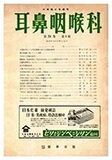- 有料閲覧
- 文献概要
上気道狭窄の際に吸気性呼吸困難を発来する事は,周知の事であり,その原因として声帯の位置形態の上から,又気管内を通る気流の影響等の上から種々の説が出されているが,私は上気道狭窄による強度の呼吸困難め際に気道に於ける最狭細部位の1つたる声門の運動状態を観察し,吸気性,呼吸困難の発来機序の解明に就て従来諸家の実験と別の点からこれを究明せんとし本実験を行つた.
IIDA, KOYAMA AND SUGAWARA experimenting on cats attempted to find the cause of the difficulty which are met with in expiration when the trachea is constricted by any means The trachea was seve-red between the first and second ring and move-ments of vocal cords as well as that of respiration were recorded on a kymograph while tracheal con-strictions of various degrees were induced. Under normal conditions of the trachea or when constricti-ons induced are only slight in degree the resting vocal cords are found to be bowing in the direction to which the air current traveled in each act of respiration, i. e., outward with expiration and inward with inspiration. With racheal constriction of an appreciable degree the positional changes in respira-tion had a tendency to lag behind with sustainance of inward bowing at the beginning of expiration.
The authors believe that this lagging in the chan-ge of position on the part of vocal cords the unde-rlying cause of difficulties met with in expiration when faced with tracheal coastrictions.
Copyright © 1952, Igaku-Shoin Ltd. All rights reserved.


